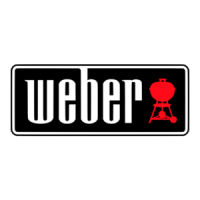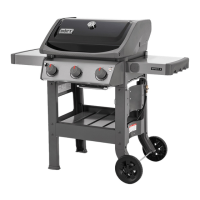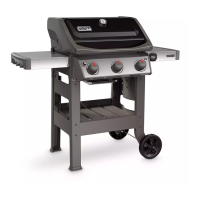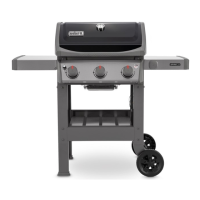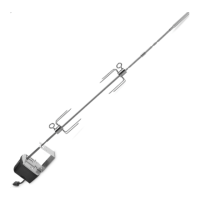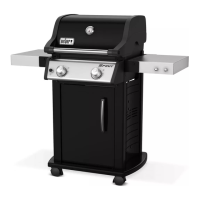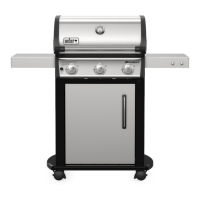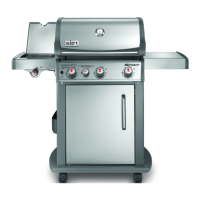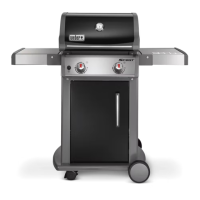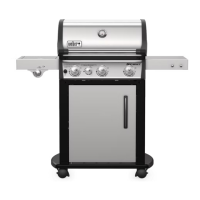Do you have a question about the Weber Spirit II E310 and is the answer not in the manual?
Provides contact details for customer service in Australia and New Zealand.
Links to Weber's social media channels for engagement and updates.
Explains the benefits of reading the manual for new users and mastering the barbecue.
Details the advantages of cooking with the barbecue lid closed for flavor and efficiency.
Overview of key parts like lid, ignition, burners, Flavorizer bars, grills, and cleaning system.
Information on the barbecue's compatibility with the iGrill accessory for temperature monitoring.
How to cook food directly over the heat source on the barbecue for searing and browning.
How to cook food away from direct heat for roasting, baking, and slow cooking.
Steps for preheating the barbecue to the correct temperature before direct cooking.
Instructions for cooking food using the direct method, including turning food.
Guidance on approximate temperature settings for various direct cooking scenarios.
Steps for preheating the barbecue for optimal indirect roasting results.
Instructions for cooking roasts using the indirect method, focusing on heat circulation.
Guidance on approximate temperature settings for indirect roasting.
Steps for preheating the barbecue to the correct temperature for baking.
Instructions for baking desserts, cakes, and pastries using the indirect method.
Guidance on approximate temperature settings for indirect baking.
Steps for preheating to achieve perfect pork crackling, requiring higher initial heat.
Instructions for cooking pork to get crispy crackling using indirect heat.
Temperature settings for cooking pork crackling, focusing on high indirect heat.
Steps to preheat the barbecue to the optimal temperature for low and slow cooking.
Instructions for cooking tougher cuts of meat slowly over extended periods.
Temperature settings for low and slow cooking, typically 100°C to 130°C.
Steps to preheat the barbecue for rotisserie cooking, ensuring even heat distribution.
Instructions for using the rotisserie accessory for self-basting spit-roasted food.
Temperature settings for rotisserie cooking, typically medium indirect heat.
Guidance on cleaning grills, Flavorizer bars, and the cookbox for optimal performance.
Maintenance of drip pans and essential tips for preventing and handling fat fires.
Recommendations for protecting the barbecue's frame with protectant spray.
Using smoker boxes and woods to add smoky flavors to barbecue dishes.
Guidance on interpreting recipe instructions, cooking methods, and measurements.
Overview of available Weber meat thermometer options for precise cooking.
Chart detailing internal meat temperatures for various types of meat to achieve desired doneness.
Details on cooking times and methods for various beef cuts on the barbecue.
Details on cooking times and methods for various lamb cuts on the barbecue.
Details on cooking times and methods for various pork cuts on the barbecue.
Details on cooking times and methods for various poultry items on the barbecue.
Details on cooking times and methods for various seafood on the barbecue.
Details on cooking times and methods for various vegetables on the barbecue.
Information on weather-resistant covers for protecting the barbecue from elements.
Details on the rotisserie kit for creating self-basting spit-roasted food.
Description of stainless steel tongs, spatula, and barbecue fork for grilling tasks.
Accessories for managing cooking juices and enhancing poultry roasting.
Tools for cleaning grills and cooking accessories like grill pans for versatile use.
Accessory for cooking ribs and roasts vertically, increasing cooking area.
Mitts, apron, and gloves designed for heat protection during barbecuing.
Smart thermometer for monitoring food temperature remotely via a smartphone app.
Quick and accurate thermometers for immediate, precise meat temperature readings.
Provides contact details for customer service in Australia and New Zealand.
Links to Weber's social media channels for engagement and updates.
Explains the benefits of reading the manual for new users and mastering the barbecue.
Details the advantages of cooking with the barbecue lid closed for flavor and efficiency.
Overview of key parts like lid, ignition, burners, Flavorizer bars, grills, and cleaning system.
Information on the barbecue's compatibility with the iGrill accessory for temperature monitoring.
How to cook food directly over the heat source on the barbecue for searing and browning.
How to cook food away from direct heat for roasting, baking, and slow cooking.
Steps for preheating the barbecue to the correct temperature before direct cooking.
Instructions for cooking food using the direct method, including turning food.
Guidance on approximate temperature settings for various direct cooking scenarios.
Steps for preheating the barbecue for optimal indirect roasting results.
Instructions for cooking roasts using the indirect method, focusing on heat circulation.
Guidance on approximate temperature settings for indirect roasting.
Steps for preheating the barbecue to the correct temperature for baking.
Instructions for baking desserts, cakes, and pastries using the indirect method.
Guidance on approximate temperature settings for indirect baking.
Steps for preheating to achieve perfect pork crackling, requiring higher initial heat.
Instructions for cooking pork to get crispy crackling using indirect heat.
Temperature settings for cooking pork crackling, focusing on high indirect heat.
Steps to preheat the barbecue to the optimal temperature for low and slow cooking.
Instructions for cooking tougher cuts of meat slowly over extended periods.
Temperature settings for low and slow cooking, typically 100°C to 130°C.
Steps to preheat the barbecue for rotisserie cooking, ensuring even heat distribution.
Instructions for using the rotisserie accessory for self-basting spit-roasted food.
Temperature settings for rotisserie cooking, typically medium indirect heat.
Guidance on cleaning grills, Flavorizer bars, and the cookbox for optimal performance.
Maintenance of drip pans and essential tips for preventing and handling fat fires.
Recommendations for protecting the barbecue's frame with protectant spray.
Using smoker boxes and woods to add smoky flavors to barbecue dishes.
Guidance on interpreting recipe instructions, cooking methods, and measurements.
Overview of available Weber meat thermometer options for precise cooking.
Chart detailing internal meat temperatures for various types of meat to achieve desired doneness.
Details on cooking times and methods for various beef cuts on the barbecue.
Details on cooking times and methods for various lamb cuts on the barbecue.
Details on cooking times and methods for various pork cuts on the barbecue.
Details on cooking times and methods for various poultry items on the barbecue.
Details on cooking times and methods for various seafood on the barbecue.
Details on cooking times and methods for various vegetables on the barbecue.
Information on weather-resistant covers for protecting the barbecue from elements.
Details on the rotisserie kit for creating self-basting spit-roasted food.
Description of stainless steel tongs, spatula, and barbecue fork for grilling tasks.
Accessories for managing cooking juices and enhancing poultry roasting.
Tools for cleaning grills and cooking accessories like grill pans for versatile use.
Accessory for cooking ribs and roasts vertically, increasing cooking area.
Mitts, apron, and gloves designed for heat protection during barbecuing.
Smart thermometer for monitoring food temperature remotely via a smartphone app.
Quick and accurate thermometers for immediate, precise meat temperature readings.
| Main Burners | 3 |
|---|---|
| Total Cooking Area | 529 square inches |
| Main Cooking Area | 424 square inches |
| Warming Rack Area | 105 square inches |
| Flavorizer Bars | Porcelain-enameled |
| Grease Management System | Yes |
| BTU-per-hour Input | 30, 000 BTU/hour |
| Fuel Type | Liquid Propane (refillable tank sold separately) |
| Weight | 114 lbs |
| Cooking Grates | Porcelain-enameled cast iron |
| Dimensions - Lid Closed | 52 x 27 x 45 inches |
